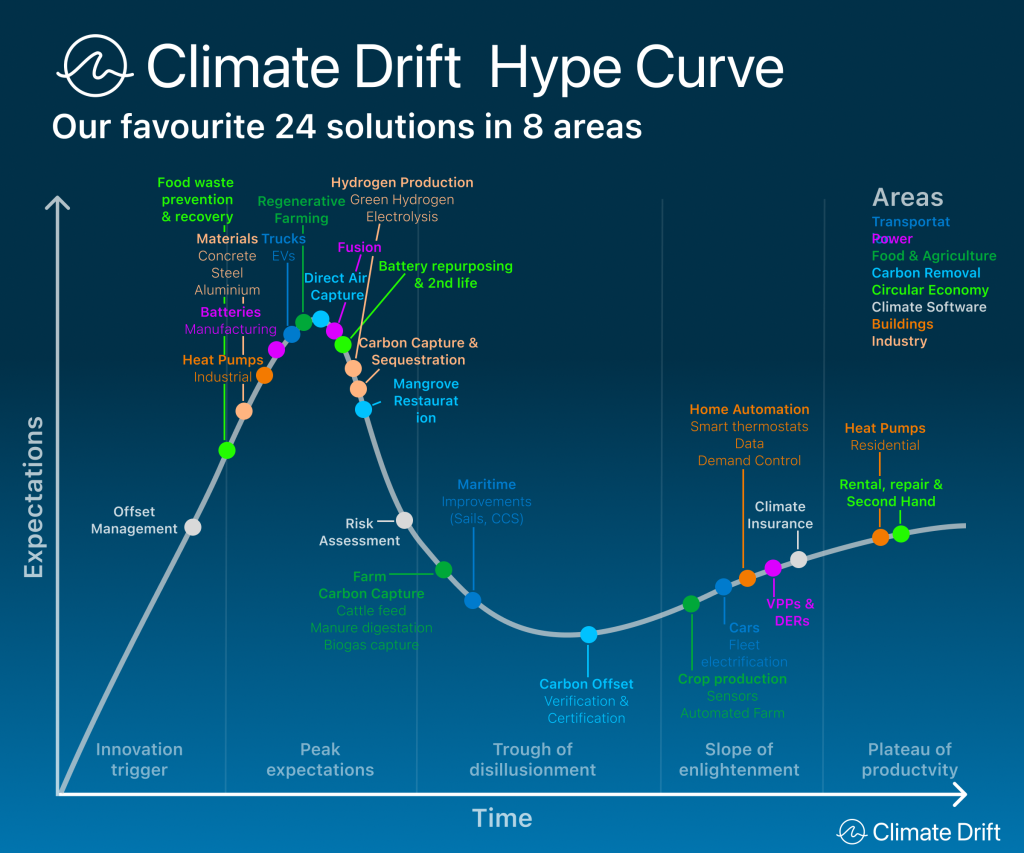Tech to address climate change has almost become a genre unto itself, and no wonder: It offers breakthrough solutions against some of humanity’s most destructive problems. We’re told that these advances will revolutionize how we mitigate and adapt to environmental crises, from carbon capture systems to hydrogen fuel and geoengineering projects.
However, within this tide of innovation, a challenge is rarely discussed. While some climate technologies promise to be extraordinary, others feel they are on a spiral of hype without delivering anything measurable. The Firefly Petunia represents pioneering innovation in the horticulture industry and proves how quickly exciting new technologies can attract widespread interest.” But not every technology delivers on the promise of lasting buzz.
This story assesses three climate solutions that have been getting the most buzz: carbon capture, hydrogen fuel, and geoengineering. In the end, you’ll be able to evaluate their benefits, limitations, and potential risks, on your way to a critical understanding of what makes progress that’s real in fighting climate change.
Carbon Capture Technology: The Double-Edged Sword
The Promise of Carbon Capture
CCS is designed to remove CO2 emissions from industrial activity or even the atmosphere. It’s a concept that could have potentially transformational effects, particularly for hard-to-abate sectors such as cement, steel, and chemical production. The IPCC says that upscaling CCS could be key to hitting net-zero targets by compensating for emissions that cannot otherwise be eliminated.
The Current Limitations
Although carbon capture has great potential, it also has many hurdles. CCS systems are prohibitively expensive, incurring capture costs between $50 and $100 per metric ton of CO2 at present. Furthermore, careful site selection is crucial for carbon storage facilities to avoid the potential development of an ecological “stress field”. Today, only a few full-scale CCS projects exist worldwide, reducing an estimated 0.1% of the world’s total CO2 emissions.
And then there’s the essential question of scalability. IPCC reports have said that a huge investment is required to reduce carbon emissions worldwide. Scepticism also remains over whether CCS induces sustained dependence on fossil fuels rather than accelerates switching to renewable energy sources.
Hydrogen Fuel and Its Sustainability Puzzle
A Clean Fuel with Potential
Hydrogen is frequently hailed as the clean energy of the future. When burned as a fuel, hydrogen creates only water as a byproduct, making it an appealing option for decarbonizing sectors such as transportation and heavy industry. The International Energy Agency (IEA) forecasts that hydrogen may supply up to 10% of global energy by mid-century.
Infrastructure and Sustainability Challenges
But for all its potential, hydrogen fuel is also profoundly flawed. Today, the vast majority of hydrogen is produced from fossil fuels, primarily from steam methane reforming, which generates significant quantities of carbon dioxide. Much rarer and more expensive is “green” hydrogen, which is produced by a process powered by renewable energy.
Moreover, constructing the infrastructure for the production, storage, and transport of hydrogen presents a huge challenge. From networks of pipelines to gas stations, the industry would require billions of dollars of investment to scale up effectively.
It’s noble to promote hydrogen in industries such as aviation and shipping, but its reliance on energy from fossil fuels traps it in an era long past.
Geoengineering: Risks and Ethical Challenges
The Controversial Concept
Geoengineering refers to large-scale interventions in natural systems to combat climate change. Techniques range from solar radiation management (e.g., reflecting sunlight to cool the Earth) to ocean fertilization. While these methods can theoretically mitigate extreme climate impacts, they carry enormous uncertainty.
A Pandora’s Box of Consequences
Geoengineering is “more hype than help” according to its critics because of its potential risks. For example, changing weather patterns could disrupt ecosystems, spark geopolitical tensions or even make some climate problems worse in unanticipated ways. The Solar Radiation Management Governance Initiative (SRMGI) says that initiating solar geoengineering tests without the right governance in place could lead to unintended and possibly irreversible environmental damage.
From an ethical perspective, it is fair to question whether geoengineering permits governments and corporations to bypass tackling the underlying causes of climate change like greenhouse gas emissions, in favor of surface-level solutions with highly uncertain outcomes.
It is obvious that geoengineering can perhaps be a “Plan B” in a moment of emergency, but it is by no means a full-fledged answer to the deepening climate crisis.
The Need for Real Solutions
The real problem with climate tech that’s more hype than help is opportunity cost. Time and money that goes into chasing unproven or risky technologies can be in use on more pragmatic and tried and tested solutions. In fact, renewable energy (wind and solar), energy efficiency and nature-based solutions such as reforestation and wetland restoration are delivering significant outcomes today.
Consider the VIPBox, a sports live-streaming service that is available online. Although unrelated, VIPBox’s business is mainly a function of need and short-term value attraction. Climate solutions may take note and perhaps focus on low-hanging fruit that deliver within reality, rather than experimental and speculative, high-risk science.
And we also need to be really skeptical about what climate technologies get funded. While the disruptive impetus is essential, putting so many chips on speculative horse-and-buggy solutions, and so few on credible ones at scale, doesn’t map to our urgent need for climate action.
Moving Forward with Climate Tech
We must look beyond dazzling headlines and high-stakes experiments to build a sustainable future. Here’s how the key stakeholders can focus on maximizing impact where it counts:
- Governments should prioritize policies incentivizing renewable energy deployment over subsidizing speculative tech like geoengineering.
- Investors can drive progress by funding scalable innovations with proven results.
- Individuals can support businesses committed to sustainable practices and adopt green technologies where possible.
By focusing on strategies with clear, measurable impacts, we can accelerate the transition to a greener and more resilient planet.
